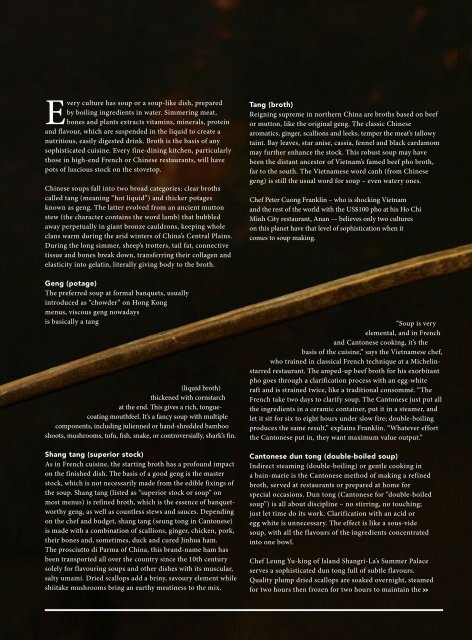Crave__February_2018
You also want an ePaper? Increase the reach of your titles
YUMPU automatically turns print PDFs into web optimized ePapers that Google loves.
Every culture has soup or a soup-like dish, prepared<br />
by boiling ingredients in water. Simmering meat,<br />
bones and plants extracts vitamins, minerals, protein<br />
and flavour, which are suspended in the liquid to create a<br />
nutritious, easily digested drink. Broth is the basis of any<br />
sophisticated cuisine. Every fine-dining kitchen, particularly<br />
those in high-end French or Chinese restaurants, will have<br />
pots of luscious stock on the stovetop.<br />
Chinese soups fall into two broad categories: clear broths<br />
called tang (meaning “hot liquid”) and thicker potages<br />
known as geng. The latter evolved from an ancient mutton<br />
stew (the character contains the word lamb) that bubbled<br />
away perpetually in giant bronze cauldrons, keeping whole<br />
clans warm during the arid winters of China’s Central Plains.<br />
During the long simmer, sheep’s trotters, tail fat, connective<br />
tissue and bones break down, transferring their collagen and<br />
elasticity into gelatin, literally giving body to the broth.<br />
Geng (potage)<br />
The preferred soup at formal banquets, usually<br />
introduced as “chowder” on Hong Kong<br />
menus, viscous geng nowadays<br />
is basically a tang<br />
(liquid broth)<br />
thickened with cornstarch<br />
at the end. This gives a rich, tonguecoating<br />
mouthfeel. It’s a fancy soup with multiple<br />
components, including julienned or hand-shredded bamboo<br />
shoots, mushrooms, tofu, fish, snake, or controversially, shark’s fin.<br />
Shang tang (superior stock)<br />
As in French cuisine, the starting broth has a profound impact<br />
on the finished dish. The basis of a good geng is the master<br />
stock, which is not necessarily made from the edible fixings of<br />
the soup. Shang tang (listed as “superior stock or soup” on<br />
most menus) is refined broth, which is the essence of banquetworthy<br />
geng, as well as countless stews and sauces. Depending<br />
on the chef and budget, shang tang (seung tong in Cantonese)<br />
is made with a combination of scallions, ginger, chicken, pork,<br />
their bones and, sometimes, duck and cured Jinhua ham.<br />
The prosciutto di Parma of China, this brand-name ham has<br />
been transported all over the country since the 10th century<br />
solely for flavouring soups and other dishes with its muscular,<br />
salty umami. Dried scallops add a briny, savoury element while<br />
shiitake mushrooms bring an earthy meatiness to the mix.<br />
Tang (broth)<br />
Reigning supreme in northern China are broths based on beef<br />
or mutton, like the original geng. The classic Chinese<br />
aromatics, ginger, scallions and leeks, temper the meat’s tallowy<br />
taint. Bay leaves, star anise, cassia, fennel and black cardamom<br />
may further enhance the stock. This robust soup may have<br />
been the distant ancestor of Vietnam’s famed beef pho broth,<br />
far to the south. The Vietnamese word canh (from Chinese<br />
geng) is still the usual word for soup – even watery ones.<br />
Chef Peter Cuong Franklin – who is shocking Vietnam<br />
and the rest of the world with the US$100 pho at his Ho Chi<br />
Minh City restaurant, Anan — believes only two cultures<br />
on this planet have that level of sophistication when it<br />
comes to soup making.<br />
“Soup is very<br />
elemental, and in French<br />
and Cantonese cooking, it’s the<br />
basis of the cuisine,” says the Vietnamese chef,<br />
who trained in classical French technique at a Michelinstarred<br />
restaurant. The amped-up beef broth for his exorbitant<br />
pho goes through a clarification process with an egg-white<br />
raft and is strained twice, like a traditional consommé. “The<br />
French take two days to clarify soup. The Cantonese just put all<br />
the ingredients in a ceramic container, put it in a steamer, and<br />
let it sit for six to eight hours under slow fire; double-boiling<br />
produces the same result,” explains Franklin. “Whatever effort<br />
the Cantonese put in, they want maximum value output.”<br />
Cantonese dun tong (double-boiled soup)<br />
Indirect steaming (double-boiling) or gentle cooking in<br />
a bain-marie is the Cantonese method of making a refined<br />
broth, served at restaurants or prepared at home for<br />
special occasions. Dun tong (Cantonese for “double-boiled<br />
soup”) is all about discipline – no stirring, no touching;<br />
just let time do its work. Clarification with an acid or<br />
egg white is unnecessary. The effect is like a sous-vide<br />
soup, with all the flavours of the ingredients concentrated<br />
into one bowl.<br />
Chef Leung Yu-king of Island Shangri-La’s Summer Palace<br />
serves a sophisticated dun tong full of subtle flavours.<br />
Quality plump dried scallops are soaked overnight, steamed<br />
for two hours then frozen for two hours to maintain the



